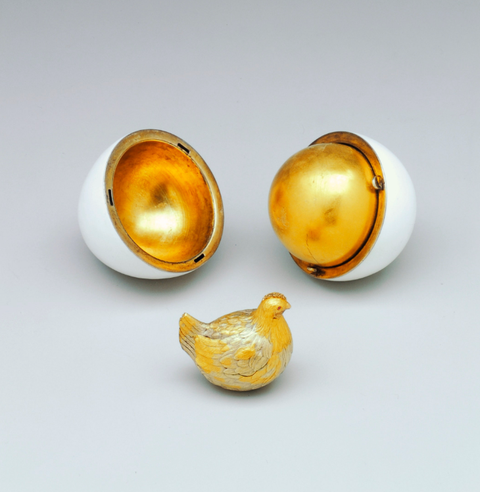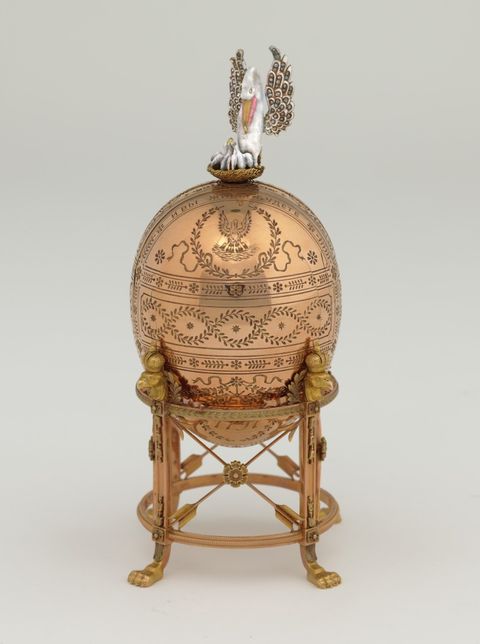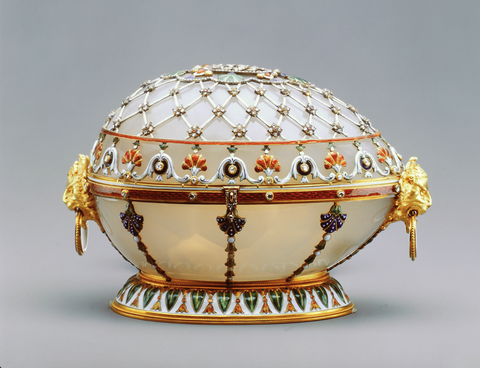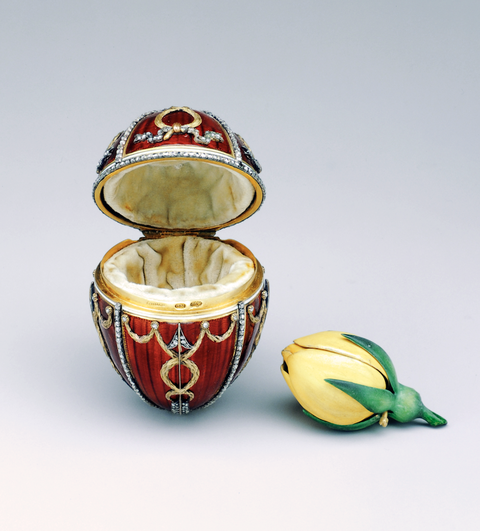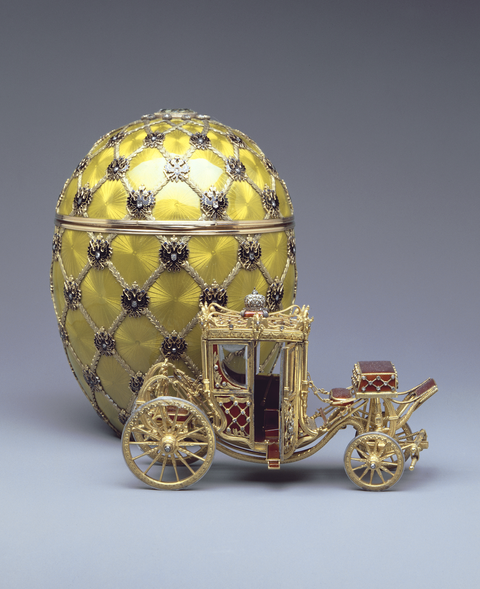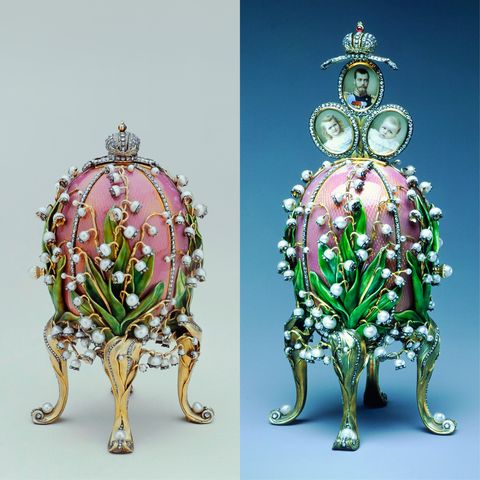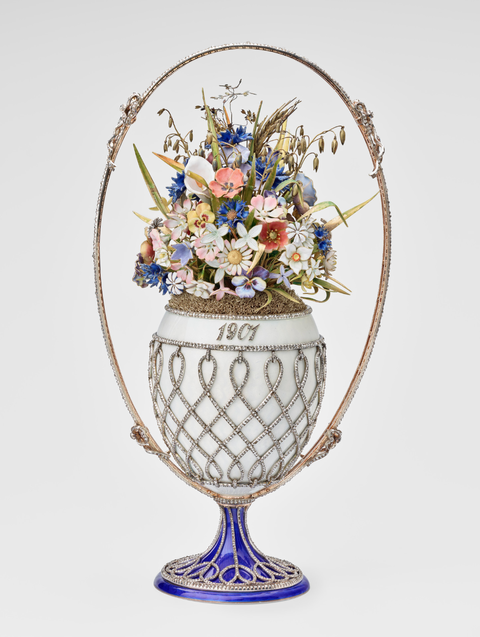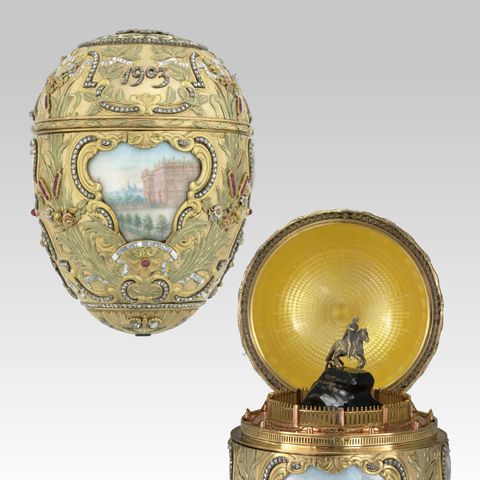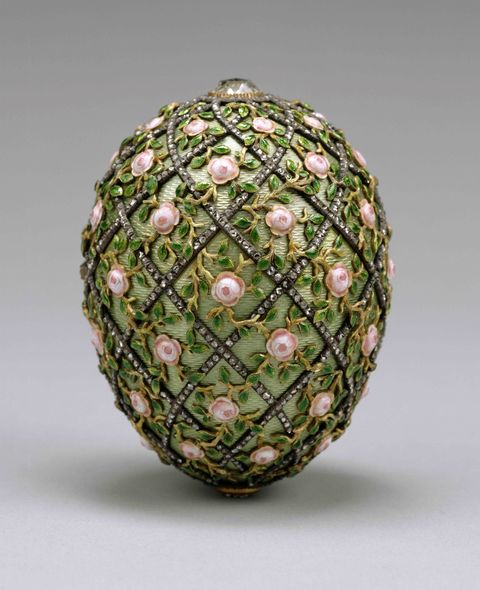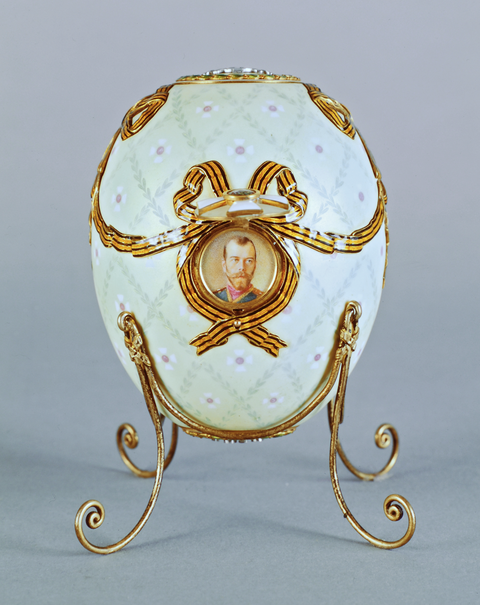The story of the imperial Fabergé Easter eggs is a fascinating one. It started in Russia in 1885 with what appeared to be an ordinary gift—a white enamel egg—but there was beauty hidden within. The egg opened to reveal a series of surprises: first, a solid gold yolk in the center, which opened to reveal a multicolored gold hen with ruby eyes, which then opened to a gold-and-diamond replica of the imperial crown, which itself contained a tiny ruby pendant suspended on a chain. The so-called Hen Egg was the beginning of a series of annual gifts from Czar Alexander III and, after his death, from his son, Nicholas II, to their wives up through 1916.
Czar Nicholas commissioned jeweler Peter Carl Fabergé to be the “goldsmith by special appointment to the imperial crown.” Fabergé was given free rein in the eggs’ designs. From a needlepoint motif to a delicate lattice, he did not hold back—not only was the outside of each an intricate work of art, but the insides were even more elaborate, with each containing a hidden surprise. Thus, the tradition of Easter eggs bearing gifts was born.
The legend drew a following of collectors and historians far and wide. In America, one of the most extensive collections is that of Lillian Thomas Pratt, who amassed five eggs in the 1930s, paying as much as $16,500 for just one (when the most expensive Ford motorcar cost a little less than $1,000). Upon her death in 1947, she bequeathed the collection to the Virginia Museum of Fine Arts.
For a historic Easter egg hunt of sorts, and to mark the 135th anniversary of this royal tradition, ED asked Sarah Fabergé, the great-granddaughter of Peter Carl; Géza von Habsburg, the great-great-grandson of Emperor Franz Joseph I of Austria and grandson of King Frederick Augustus III; and three other experts to tell us about their favorite eggs and where they are now.
1THE HEN EGG, 1885
“The Hen Egg is particularly significant, as it was the first imperial Easter egg created by my great-grandfather, Peter Carl Fabergé, for Czar Alexander III to present to his wife, Empress Maria Feodorovna, in 1885,” Fabergé says. “The czar himself had a hand in the design as he requested that the final surprise ‘be a small pendant egg of some precious stone,’ and it was so well received that it paved the way for further commissions from the imperial family and others with a taste for exquisite jewels and objets. Who knows? Without this egg, things may have been very different.” On view at the Fabergé Museum.
2THE PELICAN EGG, 1892
“The Pelican Egg opens accordion-like to reveal eight hinged oval panels with miniatures of orphanages and educational institutions, commemorating their 100th anniversaries, and of which the dowager empress was president.” Fabergé says. “The pelican in its piety surmounting the egg is a symbol of Christian charity, as it offers its own blood to save its young—a symbol of how seriously the Romanov family viewed its responsibility toward its Russian people.” Presented by Czar Nicholas II to his mother, Empress Maria Feodorovna. On view at the Virginia Museum of Fine Arts.
3THE RENAISSANCE EGG, 1894
“This was to be the last egg commissioned by Alexander III before Nicholas II took over the Easter tradition of gifting Fabergé eggs to his wife and mother every year,” explains Josina von dem Bussche-Kessell, the global sales director of Fabergé. “This piece is particularly intricate and delicate, with an exceptionally gentle mixture of materials and colors featuring Fabergé’s signature detailing. The egg was made of white agate and covered with a dainty trellis connecting individual flowers set with rubies, diamonds, and pearls. On either side of the egg is a lion’s mask with gold swing handles. Sadly, the egg’s surprise was lost, but it is believed to have featured pearls.” Presented by Czar Alexander III to his wife, Empress Maria Feodorovna. On view at the Fabergé Museum.
4THE ROSEBUD EGG, 1895
“After the untimely death of Alexander III, Nicholas continued the important relationship with the House of Fabergé and commissioned his first egg in 1895,” von dem Bussche-Kessell says. “The Rosebud Egg, widely acknowledged as predominantly honoring the new Empress Alexandra Feodorovna and her love of roses, features a beautiful yellow enamel rose on the inside—yellow roses were most precious in her native Germany at the time. The theme is also regarded as a romantic tribute to the couple’s status as newlyweds, especially symbolized in the egg’s red-enamel outer ‘shell’ and Cupid’s arrow set with rose-cut diamonds. At the top there was also a small portrait of Nicholas II. There were said to be two smaller surprises inside the yellow rosebud—a small crown and a ruby drop—but these have been lost since the Russian Revolution.” Presented by Czar Nicholas II to his wife, Empress Alexandra Feodorovna. On view at the Fabergé Museum.
5THE CORONATION EGG, 1897
“This egg is arguably one of the most recognized and loved Fabergé imperial eggs, most likely because of its reference to the ultimate imperial moment—Nicholas II’s coronation,” von dem Bussche-Kessell says. “The detail and functionality of Fabergé’s craftsmanship in this piece is unparalleled, featuring a miniature copy of the imperial coach as the egg’s surprise, complete with moving wheels, opening doors, and even a miniature folding step chair. It took the House of Fabergé more than 15 months to make the egg and required the highest level of technical as well as artistic excellence. Perfectly showcasing Fabergé’s world-renowned artistry using guilloche enameling—a technique still used by Fabergé today—the egg mesmerizes with its deep yellow color and captivating starburst engraving.” Presented by Czar Nicholas II to his wife, Empress Alexandra Feodorovna. On view at the Fabergé Museum.
6LILIES OF THE VALLEY EGG, 1898
“Both Peter Carl Fabergé and Empress Maria Feodorovna loved flowers,” Fabergé says. “You can almost smell the lilies as you look at this egg, but these exquisite little flower heads are created from pearls and rose-cut diamonds, with leaves of green enamel on gold.” As for the surprise: “There is a single pearl button on the side of this pink guilloche-enameled egg—when pressed, the crown rises to reveal three miniature portraits of Czar Nicholas II and his daughters, Olga and Tatiana.” Presented by Czar Nicholas II to his wife, Empress Alexandra Feodorovna. On view at the Fabergé Museum.
7THE BASKET OF FLOWERS, 1901
“Florals feature prominently in the Fabergé archive and are a focal point for nine imperial eggs,” says Antony Lindsay, managing director of Fabergé. “This egg is a personal favorite, with a colorful bouquet of wildflowers that celebrates the arrival of spring. Standing nine inches tall, you can picture how minute and delicate the petals are—it’s truly magnificent. The silver gilt–and-oyster guilloche enamel egg-shaped basket is mounted with a rose-diamond trellis and oval handle with four bows, all on a blue enamel base with a continuation of the diamond trellis. The bouquet features wildflowers, leaves, and husks cast in gold and decorated in colorful enamel. It is said that Empress Alexandra Feodorovna displayed the egg in her study at the Winter Palace—perhaps a reminder of the first blooms of spring after a long, cold winter.” Presented by Czar Nicholas II to his wife, Empress Alexandra Feodorovna. This egg is part of the Royal Collection Trust.
8THE GATCHINA PALACE EGG, 1901
“This egg is considered one of Fabergé’s best compositions,” says John Andrew of the Fabergé Heritage Council. “Its gold shell is superbly enameled opalescent white over a moiré guilloche ground. It is divided vertically into six panels by tiny seed pearls and horizontally at its hinged center. The panels are decorated with pink ribbon-tied swags and roses, from which hang classical motifs and symbols of the arts and sciences. It opens to reveal a superbly rendered model of the Gatchina Palace in three colors of gold—yellow, red, and green.” Presented by Czar Nicholas II to his mother, Dowager Empress Maria Feodorovna. On view at the Walters Art Museum.
9THE PETER THE GREAT EGG, 1903
“This egg commemorates 200 years of Romanov rule over the Russian people,” says von Habsburg. “It is painted with a miniature of Peter the Great and his original log cabin, dated 1703, contrasted by a miniature of Nicholas II and his Winter Palace, dated 1903. Its surprise is a miniature replica of a famous statue of Peter the Great—the miniature figure rises mechanically from the egg, silhouetted against a glorious yellow enamel background.” Presented by Czar Nicholas II to his wife, Empress Alexandra Feodorovna. On view at the Virginia Musuem of Fine Arts.
10THE ROSE TRELLIS EGG, 1907
“This egg commemorates the birth of the long-awaited Czarevitch Alexei Nikolaevich in 1904,” Andrew says. “The exterior is a joy to behold—it features rose-cut diamond trellises overlaying a translucent green-enamel shell. This delicate design is enhanced by a pink rose within each lattice, surrounded by gold vines and minuscule emerald-green leaves. Alas, the surprise is missing. According to the original Fabergé invoice, it was ‘a diamond necklace with a medallion miniature of His Imperial Highness the Grand Duke Czarevitch Alexei Nikolaevich.’ In a photograph of the empress taken in June 1908, she is wearing a similar necklace, which could well be the missing surprise. Let us hope that one day it is found.” Presented by Czar Nicholas II to his wife, Empress Alexandra Feodorovna. On view at the Walters Art Museum.
11THE COLONNADE EGG, 1910
“This beautiful, highly decorative piece is a poetic symbol of the Romanov family union,” Lindsay says. “A pink guilloche-enamel egg-shaped rotary clock, featuring rose-diamond numerals, is mounted on six columns that encircle a pair of platinum doves, representing the enduring love between the czar and czarina. Their beloved children surround the couple—the cherub surmounted on the clock symbolizes their son, Alexei, while the four silver-gilt female cherubs on the base are a touching nod to their four daughters: Olga, Tatiana, Maria, and Anastasia. This stunning mechanical piece stands at just 11 inches tall, highlighting Fabergé’s unrivaled ability to create the finest details and mechanics.” Presented by Czar Nicholas II to his wife, Empress Alexandra Feodorovna. This egg is part of the Royal Collection Trust.
12THE MOSAIC EGG, 1914
“The exquisite Mosaic Egg is one of the most iconic of all,” Lindsay says. “It is crafted from gold and platinum and pink and white enamel, pavé-set with a rainbow of rose diamonds, rubies, emeralds, topaz, sapphires, and garnets. Pearls and larger diamonds form bands around the egg, and the czarina’s initials are set in moonstone. The surprise remains intact: an ivory medallion with profiles of the czar and czarina’s five children on one side and a basket of flowers and their names on the reverse. This is undoubtedly one of the most elaborate and extraordinary of the imperial eggs, with the complex arrangement of gemstones creating a pattern like a petit point tapestry work.” Presented by Czar Nicholas II to his wife, Empress Alexandra Feodorovna. This egg is part of the Royal Collection Trust.
13THE RED CROSS EGG, 1915
“This is one of two eggs decorated with the Red Cross and crafted by the firm of Fabergé,” von Habsburg explains. “This sober egg was given by the czar to his mother, the Dowager Empress Maria Feodorovna, in honor of her presidency of the Russian Red Cross during World War I. Its surprise, a folding screen, depicts the empress flanked by her two eldest daughters, Olga and Tatiana, as well as the czar’s sister and a cousin. They are shown as Sisters of Mercy, all acting for the Red Cross at a hospital run by the empress at her Alexander Palace. To me, this egg is significant this year, as we witness the ravages of tens of thousands of victims of COVID-19.” Presented by Czar Nicholas II to his mother, Dowager Empress Maria Feodorovna. On view at the Virginia Museum of Fine Arts.
14THE ORDER OF ST. GEORGE EGG, 1916
“This egg demonstrates Fabergé’s continued ability to encompass many messages within an object,” Fabergé says. “The Order of St. George was created by Catherine the Great in 1769 and awarded to Czar Nicholas II in 1915. The use of silver for the shell is a sensitive nod toward World War I austerity. However, the variety of materials used and the attention to detail remain. Concealed buttons reveal two miniature portraits, this time of the czar and his son the czarevitch.” Presented by Czar Nicholas II to his mother, Dowager Empress Maria Feodorovna. On view at the Fabergé Museum.
